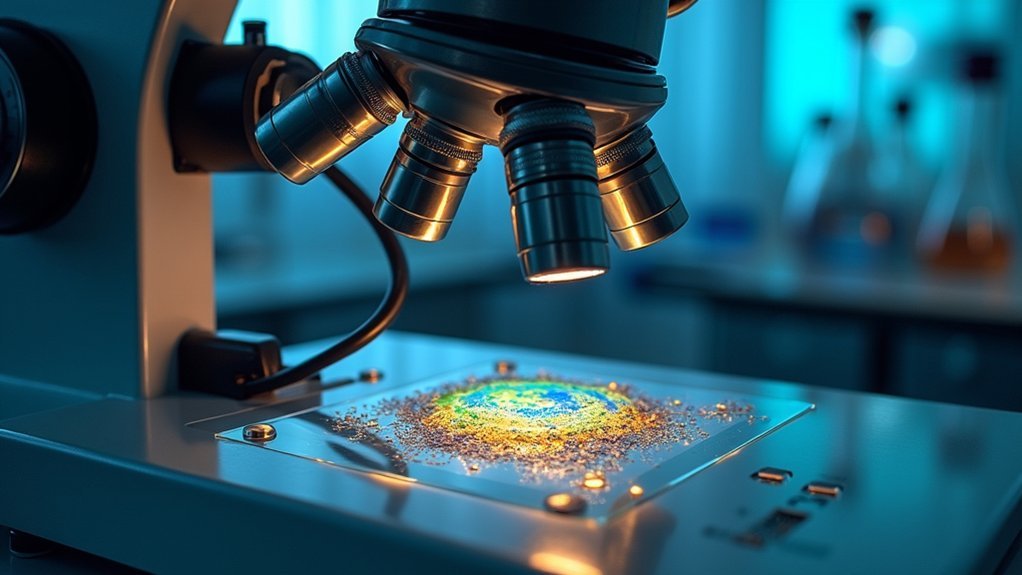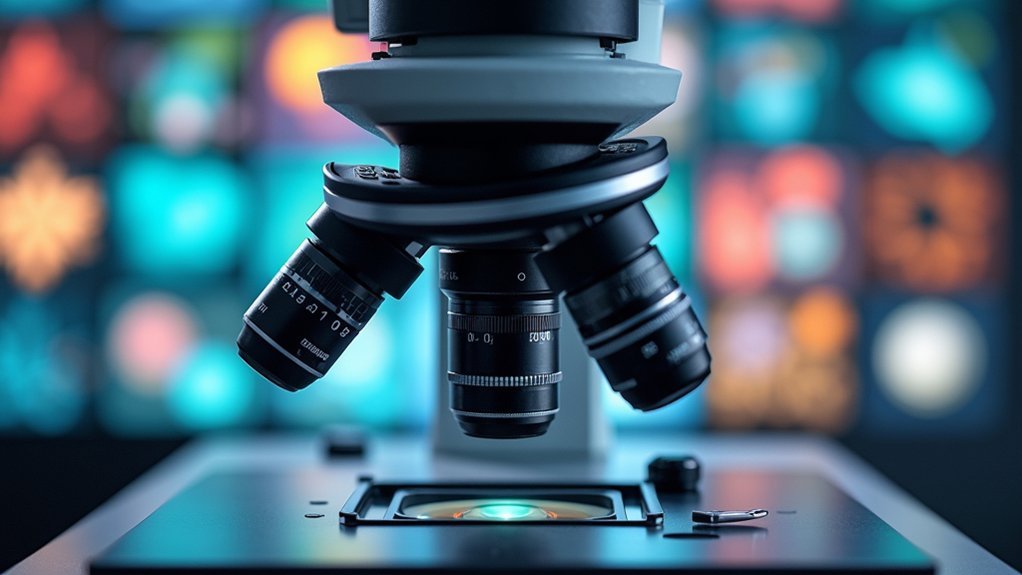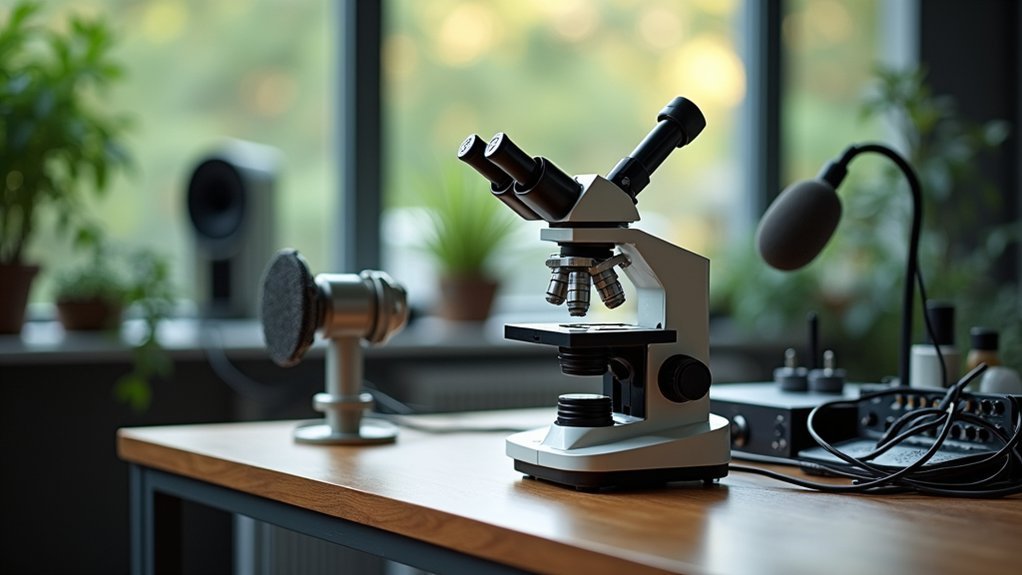To stream your microscope, you’ll need a quality camera (DSLR or mirrorless), video capture device, stable 20+ Mbps internet connection, external microphone, and proper lighting. Mount your camera securely to the microscope using adapters, then configure OBS with 720p resolution and 30fps frame rate. Test your internet connection multiple times before going live. Set up proper audio for clear commentary during your stream. The following guide covers everything you’ll need for professional microscope broadcasts.
Numeric List of 6 Second-Level Headings

When setting up your microscope stream, you’ll need to follow these six essential steps to secure professional quality.
- Camera Selection and Setup – Choose a DSLR or mirrorless camera for peak video quality.
- Audio Equipment Configuration – Install an external microphone like Rode for clear sound.
- Streaming Software Installation – Configure OBS with proper video and audio sources.
- Internet Connection Verification – Confirm stable 20+ Mbps upload speed for buffer-free live streaming.
- Resolution and Quality Settings – Set your stream to 720p for the best balance of clarity and performance.
- Testing and Performance Monitoring – Run test streams to check video/audio quality and monitor CPU usage.
Each step builds upon the previous one, creating an all-encompassing workflow for microscope streaming.
Following this systematic approach guarantees your audience receives crystal-clear visuals and audio throughout your entire broadcast.
Essential Equipment for Microscope Live Streaming
Although setting up a microscope live stream may seem complex, gathering the right equipment secures professional-quality broadcasts from the start.
Getting the right gear transforms microscope streaming from complicated to professional.
You’ll need a high-quality camera—either a DSLR, mirrorless, or specialized USB camera—to capture detailed images of each microscope slide with clarity and precision.
Connect your camera to your computer using a video capture device like the Blackmagic Design UltraStudio Mini Recorder. For smooth streaming, verify your internet connection provides at least 20 mbps upload speed.
Don’t overlook audio quality—an external microphone is essential if you’ll be providing commentary during your live stream.
Install Open Broadcaster Software (OBS) to manage your video settings and optimize your broadcast quality.
Finally, incorporate proper LED lighting to illuminate specimens clearly for your viewers.
Camera Selection and Mounting Options for Microscopy

Selecting the right camera for microscope streaming can make a dramatic difference in your final image quality, with options ranging from dedicated microscope cameras with USB interfaces to DSLRs and mirrorless cameras that offer superior manual controls.
You’ll need to verify your chosen camera properly attaches to your microscope through compatible mounts for either the eyepiece or trinocular port, maintaining perfect alignment for crisp imaging.
A stable mounting solution, whether through a specialized adapter or tripod setup, will eliminate vibrations that could otherwise blur your microscopic subjects during live streaming sessions.
Camera Types Compared
Because high-quality imaging forms the backbone of any effective microscopy stream, choosing the right camera deserves careful consideration.
DSLRs and mirrorless cameras offer superior video quality with adjustable settings that give you complete control over your live video presentation. The Sony a7 III stands out as an excellent option for professional-grade streams where image clarity is paramount.
GoPro cameras provide a compact, hands-free alternative for demonstrations but may require supplementary audio equipment.
For the most streamlined setup, dedicated microscope cameras attach directly to your instrument with optimized imaging capabilities.
Remember that DSLRs and mirrorless options typically need a capture card like the Blackmagic Design UltraStudio Mini Recorder to connect to your computer when setting up your Stream Key.
Whichever camera you select, make sure it supports at least 720p resolution for effective live demonstrations.
Mounting Solutions Explained
A stable mounting system forms the foundation of clear, professional microscopy streams. When connecting your camera to your microscope, you’ll need appropriate mounting solutions that match both devices for ideal results.
C-mount adapters provide direct attachment to microscope eyepieces, ensuring stability and precise image capture. For external cameras, a tripod or dedicated microscope camera mount will greatly reduce vibrations and improve image clarity during streaming.
| Mount Type | Best For | Considerations |
|---|---|---|
| C-mount | Dedicated microscope cameras | Direct compatibility, minimal light loss |
| Eyepiece adapter | DSLRs/mirrorless | Requires proper diameter matching |
| Tripod setup | GoPros, smartphones | Provides flexibility but less stability |
| Articulating arm | All camera types | Adjustable positioning, requires counterbalance |
Remember to align your mounting solution with your camera’s sensor size and resolution to maximize detail in your microscopic livestreams.
Configuring OBS for High-Quality Microscope Streaming
Once you’ve installed OBS Studio, proper configuration is essential for capturing clear microscope imagery. Start by setting your Base and Output Resolution to 1280×720 in Settings, providing quality without excessive bandwidth when you Go Live.
Add your microscope as a source using the Video Capture Device option, selecting the correct camera from the dropdown menu to Start Streaming effectively. Set your frame rate to 30 fps for smooth video performance with your Camera For Live broadcasts.
To capture audio alongside your microscope footage, configure the Audio Sample Rate to 44.1 kHz and set Channels to Stereo.
Monitor your CPU usage during streams, keeping it below 70% to prevent performance issues while broadcasting your microscopic discoveries.
Audio Setup and Environmental Considerations

While visual clarity remains paramount in microscope streaming, your audio quality can make or break the viewer experience. Invest in an external microphone, such as a shotgun or lavalier, rather than relying on built-in options that capture unwanted background noise.
Position your mic close to where you’ll be speaking, guaranteeing it doesn’t block viewers’ view of specimens or microscope operations.
Create a quiet environment for streaming by eliminating potential distractions. If you’re broadcasting outdoors or in noisy settings, consider using a windscreen to minimize ambient interference.
Before going live, always test your audio levels in OBS to ascertain your voice comes through clearly and balances well with any background music or environmental sounds you choose to include.
Bandwidth Requirements and Internet Connection Testing
Reliable internet connectivity forms the backbone of any successful microscope streaming setup. You’ll need a minimum upload speed of 20 Mbps to prevent freezing and buffering during your live streams. Before going live, always run a speed test using tools like speedtest.net to verify your connection meets streaming requirements.
| Connection Type | Recommended Speed | Benefits |
|---|---|---|
| Ethernet (Wired) | 20+ Mbps | Maximum stability |
| Wi-Fi 5GHz | 20+ Mbps | Good mobility |
| Wi-Fi 2.4GHz | 20+ Mbps | Extended range |
| Mobile Hotspot | 20+ Mbps | Portability |
| Satellite | 20+ Mbps | Remote locations |
For peak performance, make sure your internet upload bandwidth is at least 1.5 times higher than your stream’s bitrate. Hard-wire your setup via Ethernet whenever possible for enhanced reliability. Test your connection multiple times before your event to identify and resolve potential issues.
Frequently Asked Questions
What Equipment Do I Need to Start Live Streaming?
You’ll need a quality camera (DSLR/mirrorless), external microphone, powerful computer, capture device, streaming software like OBS, and stable internet with 20+ Mbps upload speed to start live streaming effectively.
How to Do Live Video Streaming?
To do live video streaming, you’ll need stable internet, a good camera, and streaming software like OBS. Configure your resolution and bitrate, add your stream key, then test everything before going live.
Do You Need 1000 Subscribers to Live Stream?
No, you don’t need 1,000 subscribers to live stream on YouTube anymore. You can stream from mobile with just 50 subscribers, though desktop streaming via third-party encoders is available for all verified accounts.
How Much Does It Cost to Stream Live on Facebook?
Streaming live on Facebook is free. You’ll only pay for your equipment (camera, microphone) and a good internet connection with at least 20 Mbps upload speed. Optional business features cost extra if you want analytics.
In Summary
You’ve learned all the essentials—from choosing the right camera to optimizing your OBS settings and testing your internet connection. With your equipment configured and environment prepared, you’re fully equipped to share fascinating microscopic discoveries with viewers worldwide. Don’t hesitate to experiment with different setups as you gain experience. Your unique microscopic perspective is now just a stream away!





Leave a Reply